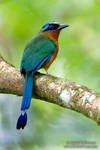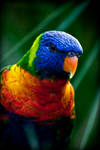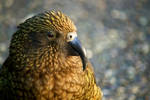ShopDreamUp AI ArtDreamUp
Deviation Actions
Birds, Part I: Palaeognathae, Anseriformes, Galliformes ciameth.deviantart.com/journal…
Birds, Part II: Columbiformes, Pteroclidiformes, Eurypygidae and Rhynochetidae, Mesitornithiformes, Phaethontiformes, Opisthocomiformes, Podicipediformes and Phoenicopteriformes ciameth.deviantart.com/journal…
Birds, Part III: Apodiformes, Aegotheliformes, Caprimulgiformes, Musophagiformes, Cuculiformes, Otidae and Gruiformes ciameth.deviantart.com/journal…
Birds, Part IV: Pelecaniformes, Procellariiformes, Ciconiiformes, Sphenisciformes, and Gaviiformes ciameth.deviantart.com/journal…
Birds, Part V: Charadriiformes, Cariamae and Coliiformes ciameth.deviantart.com/journal…
Birds, Part VI: Accipitriformes, Strigiformes, Trogoniformes and Bucerotiformes ciameth.deviantart.com/journal…
In this second-to-last Birds feature, we're looking at Coraciiformes (kingfishers, rollers, bee-eaters, todies, and motmots), Piciformes (woodpeckers, toucans, barbets, honeyguides, jacamars and puffbirds), Leptosomatiformes (the cuckoo-roller), Falconiformes (falcons) and Psittaciformes (parrots). The first three of those orders form a monophyletic group with two orders covered last time, the Trogoniformes and Bucerotiformes. The later two--you may or may not be surprised to hear--form a monophyletic group with the Passeriformes (perching birds, the most populous order of all). Yes, that's right! According to the latest genetic and morphological studies, falcons and parrots share a common ancestor with today's sparrows, corvids, warblers, etc.
The name Coraciiformes means "raven-like." Though most Coraciiformes have strong, multipurpose bills (which ravens--and many birds--also have), they really aren't very raven-like. They're colorful and have synodactyl feet instead of anisodactyl feet like perching birds, which means toes three and four are fused at the base. This order has six families, the Meropidae (bee-eaters), Brachypteraciidae (ground rollers), Coraciidae (rollers), Todidae (todies), Alcedinidae (kingfishers), and Momotidae (the motmots, one of the silliest bird names out there). Kingfishers, once divided into three families, are now found in three subfamilies: alcedininae (river kingfishers, found on every continent but the Americas and Antarctica), cerylinae (belted kingfishers, confined to the Americas), and daceioninae (found in Asia, Australasia, and Africa). Their are many beautiful birds in this order, but my personal favorite is the Turquoise-crowned Motmot upload.wikimedia.org/wikipedia… . Most people have never heard of Motmots, but they are some of the prettiest birds in the world. There is only one species in the order Leptosomatiformes, the Cuckoo-roller Leptosomus discolor upload.wikimedia.org/wikipedia… . Very little is known about the Cuckoo-roller. It is a primitive bird that includes chameleons and other small vertebrates in its diet. It dispatches prey by beating it to death. The feet may be zygodactyl; they don't quite fit in with any other foot type. Surprisingly, for a bird so under-studied, the Cuckoo-roller is not reported to be reclusive or afraid of people, is not hunted, and numbers appear to be resistant to habitat-loss in its native Madagascar.
:thumb165862688:

 :thumb177650550:
:thumb177650550:



 :thumb140977389:
:thumb140977389:


Piciformes are well-known birds. Woodpeckers and toucans are particularly famous. There are eight families in this order: the picidae (woodpeckers) and indicatoridae (honeyguides), the bucconidae (puffbirds) and galbulidae (jacamars), and the lybiidae (African barbets), capitonidae (American barbets), megalaimidae (Asian barbets), and ramphastidae (toucans). These birds don't look very much like each other, so what makes them an order? Aside from genetics, all piciformes are zygodactyl (two toes forward, two toes back), nest in cavities and--most unusually--do not have down feathers at any age. Most piciformes are insectivorous, but toucans eat fruit and honeyguides are capable of digesting beeswax!




:thumb182329499: :thumb149071251:
:thumb149071251:



The order Falconiformes once included all the Accipitriformes but is now reduced to one family--the falcons. As a whole, species in the family are easy to distinguish as falconidae. They have raptorial feet, sharp, hooked beaks, large eyes, pointed wings, and a naked cere (the fleshy part above the bill). Unlike Accipitriformes, the beaks of falcons have a tomial tooth and the nares of many species have tiny tubercles within the nostril to help break up airflow while traveling at high speeds www.adirondackwildlife.org/Per… . The Peregrine Falcon Falco peregrinus is the fastest recorded animal on the planet, hitting speeds over 200mph in a dive. On a flat plane, however, it can be outflown and outdistanced by the lowly pigeon (one of its favorite foods). One other difference between accipitriformes and falconiformes is that the former tend to kill their prey with the grasping power in their feet while the latter kill upon impact (Peregrine Falcons often strike their prey midair with feet balled like fists), or with their beak. Most falcons are various shades of brown or gray but some come in striking patterns, such as the Collared Falconet Microhierax caerulescens, the American Kestrel Falco sparverius, and the Red-headed Falcon Falco chicquera.
 :thumb193558729:
:thumb193558729:
 :thumb117921203:
:thumb117921203:
:thumb203941367:

Psittaciformes are some of the most popular companion birds, to the detriment of many species. There are three families in the order--the Cacatuidae (cockatoos), the Psittacidae (true parrots), and the Strigopidae (New Zealand parrots)--all of which are known for their intelligence, social gregariousness, and color. Trapping for the pet trade, hunting, and habitat loss have taken a major toll on species in each of those families. According to the IUCN, 37% of parrot species are either threatened, endangered, or extinct in the wild. Some species, like the New Caledonian Lorikeet Charmosyna diadema www.oiseaux.net/photos/john.ge… , are not yet officially listed as extinct but have not been seen alive in over 100 years.
 :thumb97794526:
:thumb97794526:





 :
:





The next birds feature will focus solely on Passeriformes, the largest order of birds!
Birds, Part II: Columbiformes, Pteroclidiformes, Eurypygidae and Rhynochetidae, Mesitornithiformes, Phaethontiformes, Opisthocomiformes, Podicipediformes and Phoenicopteriformes ciameth.deviantart.com/journal…
Birds, Part III: Apodiformes, Aegotheliformes, Caprimulgiformes, Musophagiformes, Cuculiformes, Otidae and Gruiformes ciameth.deviantart.com/journal…
Birds, Part IV: Pelecaniformes, Procellariiformes, Ciconiiformes, Sphenisciformes, and Gaviiformes ciameth.deviantart.com/journal…
Birds, Part V: Charadriiformes, Cariamae and Coliiformes ciameth.deviantart.com/journal…
Birds, Part VI: Accipitriformes, Strigiformes, Trogoniformes and Bucerotiformes ciameth.deviantart.com/journal…
In this second-to-last Birds feature, we're looking at Coraciiformes (kingfishers, rollers, bee-eaters, todies, and motmots), Piciformes (woodpeckers, toucans, barbets, honeyguides, jacamars and puffbirds), Leptosomatiformes (the cuckoo-roller), Falconiformes (falcons) and Psittaciformes (parrots). The first three of those orders form a monophyletic group with two orders covered last time, the Trogoniformes and Bucerotiformes. The later two--you may or may not be surprised to hear--form a monophyletic group with the Passeriformes (perching birds, the most populous order of all). Yes, that's right! According to the latest genetic and morphological studies, falcons and parrots share a common ancestor with today's sparrows, corvids, warblers, etc.
The name Coraciiformes means "raven-like." Though most Coraciiformes have strong, multipurpose bills (which ravens--and many birds--also have), they really aren't very raven-like. They're colorful and have synodactyl feet instead of anisodactyl feet like perching birds, which means toes three and four are fused at the base. This order has six families, the Meropidae (bee-eaters), Brachypteraciidae (ground rollers), Coraciidae (rollers), Todidae (todies), Alcedinidae (kingfishers), and Momotidae (the motmots, one of the silliest bird names out there). Kingfishers, once divided into three families, are now found in three subfamilies: alcedininae (river kingfishers, found on every continent but the Americas and Antarctica), cerylinae (belted kingfishers, confined to the Americas), and daceioninae (found in Asia, Australasia, and Africa). Their are many beautiful birds in this order, but my personal favorite is the Turquoise-crowned Motmot upload.wikimedia.org/wikipedia… . Most people have never heard of Motmots, but they are some of the prettiest birds in the world. There is only one species in the order Leptosomatiformes, the Cuckoo-roller Leptosomus discolor upload.wikimedia.org/wikipedia… . Very little is known about the Cuckoo-roller. It is a primitive bird that includes chameleons and other small vertebrates in its diet. It dispatches prey by beating it to death. The feet may be zygodactyl; they don't quite fit in with any other foot type. Surprisingly, for a bird so under-studied, the Cuckoo-roller is not reported to be reclusive or afraid of people, is not hunted, and numbers appear to be resistant to habitat-loss in its native Madagascar.
:thumb165862688:


 :thumb177650550:
:thumb177650550:



 :thumb140977389:
:thumb140977389:


Piciformes are well-known birds. Woodpeckers and toucans are particularly famous. There are eight families in this order: the picidae (woodpeckers) and indicatoridae (honeyguides), the bucconidae (puffbirds) and galbulidae (jacamars), and the lybiidae (African barbets), capitonidae (American barbets), megalaimidae (Asian barbets), and ramphastidae (toucans). These birds don't look very much like each other, so what makes them an order? Aside from genetics, all piciformes are zygodactyl (two toes forward, two toes back), nest in cavities and--most unusually--do not have down feathers at any age. Most piciformes are insectivorous, but toucans eat fruit and honeyguides are capable of digesting beeswax!




:thumb182329499:
 :thumb149071251:
:thumb149071251:


The order Falconiformes once included all the Accipitriformes but is now reduced to one family--the falcons. As a whole, species in the family are easy to distinguish as falconidae. They have raptorial feet, sharp, hooked beaks, large eyes, pointed wings, and a naked cere (the fleshy part above the bill). Unlike Accipitriformes, the beaks of falcons have a tomial tooth and the nares of many species have tiny tubercles within the nostril to help break up airflow while traveling at high speeds www.adirondackwildlife.org/Per… . The Peregrine Falcon Falco peregrinus is the fastest recorded animal on the planet, hitting speeds over 200mph in a dive. On a flat plane, however, it can be outflown and outdistanced by the lowly pigeon (one of its favorite foods). One other difference between accipitriformes and falconiformes is that the former tend to kill their prey with the grasping power in their feet while the latter kill upon impact (Peregrine Falcons often strike their prey midair with feet balled like fists), or with their beak. Most falcons are various shades of brown or gray but some come in striking patterns, such as the Collared Falconet Microhierax caerulescens, the American Kestrel Falco sparverius, and the Red-headed Falcon Falco chicquera.
 :thumb193558729:
:thumb193558729:
 :thumb117921203:
:thumb117921203::thumb203941367:


Psittaciformes are some of the most popular companion birds, to the detriment of many species. There are three families in the order--the Cacatuidae (cockatoos), the Psittacidae (true parrots), and the Strigopidae (New Zealand parrots)--all of which are known for their intelligence, social gregariousness, and color. Trapping for the pet trade, hunting, and habitat loss have taken a major toll on species in each of those families. According to the IUCN, 37% of parrot species are either threatened, endangered, or extinct in the wild. Some species, like the New Caledonian Lorikeet Charmosyna diadema www.oiseaux.net/photos/john.ge… , are not yet officially listed as extinct but have not been seen alive in over 100 years.
 :thumb97794526:
:thumb97794526:





 :
:





The next birds feature will focus solely on Passeriformes, the largest order of birds!
Ciameth Commission Information
I specialize in wildlife, pet, fantasy and anthropomorphic art. To request a commission, e-mail caraclie@gmail.com with "commission" somewhere in the subject line. Provide a description of what you want, including the type of art you want to commission. Photographic references are required for pet portraits. For all other subject material, client-supplied references are appreciated but not mandatory.
Once the general idea of the commission is settled, send the allotted payment via Paypal. Local clients may pay in person. When the money is received, I will begin working.
For ink sketches/drawings and digital character drawings, you will rec
Prism AP Tracker
PRISM 10247
________________________________________________
Handler: Caraclie & Falakros
TYPE: Common Corva
GENOTYPE: EE/aa/ss/nBl/nPn/nU/nRng/nHm/nCn/nO/nJ/nD
PHENOTYPE: Ringed Canary Olive Jay Dual Nox Pangare with Helm, Unders, and Blanket
ASCENSION STATUS
________________________________________________
AP AMOUNT: 41
75 AP = Apparel/Paint
150 AP = Alpha Status
300 AP = Legendary Status
500 AP = Ascended Status
BREEDINGS
________________________________________________
Slots= 1/5 used
1. Bred to Cinnamon Spice 6057 https://comments.deviantart.com/1/762675607/4649754730
TRAINING
_________________________________________
Marigold 104 Tracker
RANK STATUS
XP Counting Links:Artwork by Others
Personal Artwork
QuestingHunting
Monthly Prompts
Rites (Adventure/Magic/Age)
_________________________________________
Total Experience Points: 46 XP
_________________________________________
Denizen: 0 XP
3 breeding slots (3 Total)
May bring back 1-2 items while Hunting.
30% success rate while Questing
Recognized: 150 XP
+5 breeding slots (8 total)
May bring back 1-3 items while Hunting.
45% success rate while Questing
Luminary: 300 XP
+10 breeding slots (18 total)
May bring back 2-3 items while Hunting.
60% success rate while Questing
Chancellor: 450 XP
+12 breeding slots (30 tota
Creosote AP Tracker
CREOSOTE 9667
________________________________________________
Handler: Falakros
TYPE: Frilled Tyto
GENOTYPE: Ee/Aa/Ss/nSbl/nSc/nU/nCl/nSr/nStr/nEy/nSbc
PHENOTYPE: Sunrise Scorched Sunbleached Cloudy Sable Melanistic Sand with Unders, Streaks and Eyelets
ASCENSION STATUS
________________________________________________
AP AMOUNT: 209
75 AP = Apparel/Paint
150 AP = Alpha Status
300 AP = Legendary Status
500 AP = Ascended Status
BREEDINGS
________________________________________________
Slots= 0/5 used
1: AzureGryphon https://www.deviantart.com/comments/1/787716627/4725788753
2: AzureGryphon https://www.deviantart.com/comments/1
© 2011 - 2024 Ciameth
Comments9
Join the community to add your comment. Already a deviant? Log In
Wow thats an amazing feature! Im really happy to be apart of it, thank you! Its a good read too, well done
